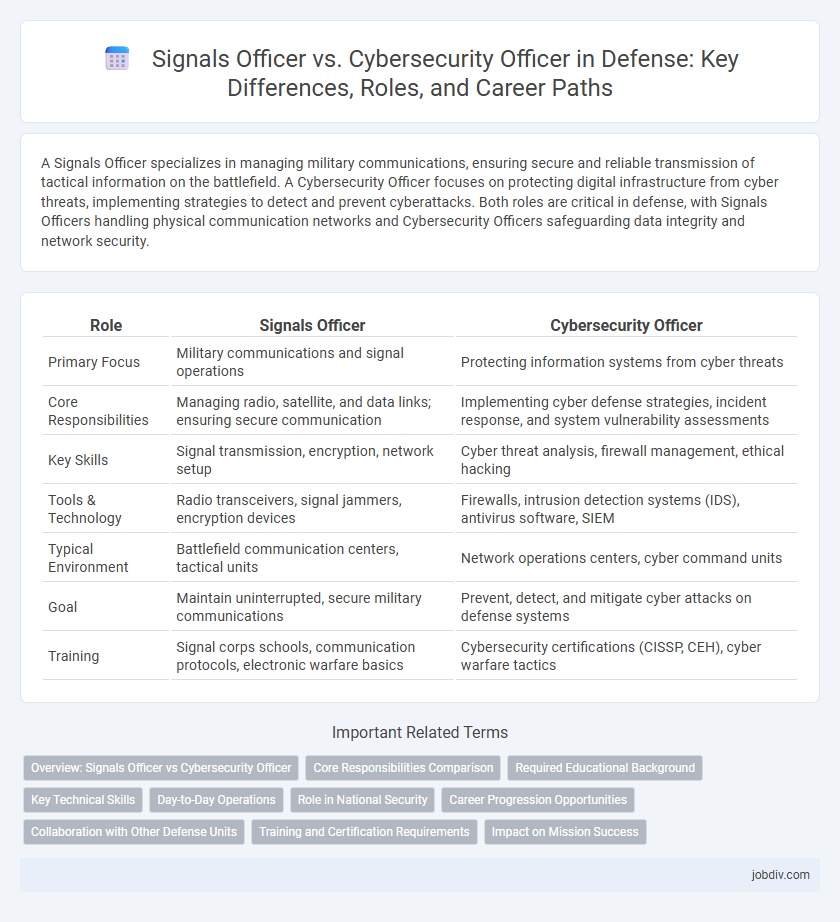A Signals Officer specializes in managing military communications, ensuring secure and reliable transmission of tactical information on the battlefield. A Cybersecurity Officer focuses on protecting digital infrastructure from cyber threats, implementing strategies to detect and prevent cyberattacks. Both roles are critical in defense, with Signals Officers handling physical communication networks and Cybersecurity Officers safeguarding data integrity and network security.
Table of Comparison
| Role | Signals Officer | Cybersecurity Officer |
|---|---|---|
| Primary Focus | Military communications and signal operations | Protecting information systems from cyber threats |
| Core Responsibilities | Managing radio, satellite, and data links; ensuring secure communication | Implementing cyber defense strategies, incident response, and system vulnerability assessments |
| Key Skills | Signal transmission, encryption, network setup | Cyber threat analysis, firewall management, ethical hacking |
| Tools & Technology | Radio transceivers, signal jammers, encryption devices | Firewalls, intrusion detection systems (IDS), antivirus software, SIEM |
| Typical Environment | Battlefield communication centers, tactical units | Network operations centers, cyber command units |
| Goal | Maintain uninterrupted, secure military communications | Prevent, detect, and mitigate cyber attacks on defense systems |
| Training | Signal corps schools, communication protocols, electronic warfare basics | Cybersecurity certifications (CISSP, CEH), cyber warfare tactics |
Overview: Signals Officer vs Cybersecurity Officer
Signals Officers manage military communications systems, ensuring secure and reliable transmission of orders and intelligence across operational theaters. Cybersecurity Officers focus on protecting information infrastructure from cyber threats by implementing defensive protocols, threat detection, and incident response strategies. While Signals Officers maintain communication integrity in tactical environments, Cybersecurity Officers safeguard digital assets against cyber espionage and sabotage in both military and civilian networks.
Core Responsibilities Comparison
A Signals Officer manages communication systems, ensuring secure and reliable transmission of military information using radio, satellite, and encrypted channels to maintain battlefield connectivity. In contrast, a Cybersecurity Officer focuses on protecting digital infrastructure, defending against cyber threats, conducting risk assessments, and implementing cybersecurity protocols to safeguard sensitive defense data. Both roles are critical for operational security, with Signals Officers emphasizing physical communication networks and Cybersecurity Officers specializing in virtual threat mitigation within defense environments.
Required Educational Background
Signals Officers typically require a bachelor's degree in electrical engineering, telecommunications, or information technology, emphasizing signal processing and communications systems. Cybersecurity Officers often hold degrees in computer science, cybersecurity, or information assurance, focusing on network security, threat analysis, and risk management. Both roles benefit from certifications such as CISSP or CompTIA Security+, but Signals Officers have a stronger foundation in signal transmission and encryption technologies.
Key Technical Skills
Signals Officers specialize in radio communications, electronic warfare, and signal intelligence, mastering encryption, frequency management, and signal interception techniques crucial for secure battlefield communication. Cybersecurity Officers focus on network defense, threat detection, and incident response, utilizing skills in penetration testing, malware analysis, and firewall configuration to protect military information systems. Both roles require proficiency in cryptographic protocols and real-time data analysis but differ significantly in their operational environments and technical toolsets.
Day-to-Day Operations
Signals Officers manage communication systems, monitoring radio frequencies and encryption protocols to ensure secure and reliable transmission of information during military operations. Cybersecurity Officers focus on protecting digital infrastructure by detecting cyber threats, conducting vulnerability assessments, and implementing defense mechanisms against cyber-attacks. Both roles require continuous vigilance and coordination to maintain operational security and support mission success in complex defense environments.
Role in National Security
Signals Officers specialize in intercepting, analyzing, and managing military communications and electronic signals to provide actionable intelligence on the battlefield. Cybersecurity Officers focus on protecting critical national defense infrastructure from cyber threats, ensuring the integrity and confidentiality of sensitive military data. Both roles are crucial in maintaining operational security and safeguarding national security against diverse threats in electronic and cyber domains.
Career Progression Opportunities
A Signals Officer's career progression often includes roles in tactical communications, electronic warfare, and intelligence operations, with potential advancement to senior command and staff positions overseeing battlefield communication systems. In contrast, a Cybersecurity Officer typically advances through increasingly specialized roles in network defense, cyber threat analysis, and digital forensics, leading to strategic positions managing cyber defense initiatives and policy development within defense agencies. Both career paths require continuous technical training and offer opportunities to influence national security through evolving defense technologies and cyber operations.
Collaboration with Other Defense Units
Signals Officers coordinate closely with intelligence and electronic warfare units to ensure secure, reliable communication channels and real-time signal interception. Cybersecurity Officers collaborate with network defense teams and information assurance personnel to protect military systems from cyber threats and maintain operational integrity. Both roles require seamless integration with command, control, and cyber operations centers to enhance situational awareness and mission success.
Training and Certification Requirements
Signals Officers typically require specialized training in electronic warfare, communications systems, and radio frequency management, often obtained through military academies or defense-specific programs. Cybersecurity Officers must achieve certifications such as CISSP, CEH, or CompTIA Security+, combined with rigorous training in network defense, threat analysis, and incident response. Both roles demand continuous education to stay updated on evolving technologies, but Cybersecurity Officers often engage more heavily in formal certification paths recognized by the civilian industry.
Impact on Mission Success
Signals Officers ensure mission success by managing secure communications and real-time information flow, which is critical for operational coordination and decision-making in defense environments. Cybersecurity Officers protect mission integrity by defending military networks against cyber threats, preventing data breaches that could compromise strategic advantages. Together, their roles synergize to maintain communication reliability and safeguard sensitive information, directly influencing the effectiveness and security of defense missions.
Signals Officer vs Cybersecurity Officer Infographic

 jobdiv.com
jobdiv.com